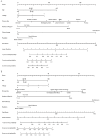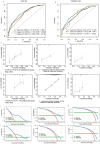Machine learning to predict distant metastasis and prognostic analysis of moderately differentiated gastric adenocarcinoma patients: a novel focus on lymph node indicators
- PMID: 39364413
- PMCID: PMC11446832
- DOI: 10.3389/fimmu.2024.1398685
Machine learning to predict distant metastasis and prognostic analysis of moderately differentiated gastric adenocarcinoma patients: a novel focus on lymph node indicators
Abstract
Background: Moderately differentiated gastric adenocarcinoma (MDGA) has a high risk of metastasis and individual variation, which strongly affects patient prognosis. Using large-scale datasets and machine learning algorithms for prediction can improve individualized treatment. The specific efficacy of several lymph node indicators in predicting distant metastasis (DM) and patient prognosis in MDGA remains obscure.
Methods: We collected data from MDGA patients from the SEER database from 2010 to 2019. Additionally, we collected data from MDGA patients in China. We used nine machine learning algorithms to predict DM. Subsequently, we used Cox regression analysis to determine the risk factors affecting overall survival (OS) and cancer-specific survival (CSS) in DM patients and constructed nomograms. Furthermore, we used logistic regression and Cox regression analyses to assess the specific impact of six lymph node indicators on DM incidence and patient prognosis.
Results: We collected data from 5,377 MDGA patients from the SEER database and 109 MDGC patients from hospitals. T stage, N stage, tumor size, primary site, number of positive lymph nodes, and chemotherapy were identified as independent risk factors for DM. The random forest prediction model had the best overall predictive performance (AUC = 0.919). T stage, primary site, chemotherapy, and the number of regional lymph nodes were identified as prognostic factors for OS. Moreover, T stage, number of regional lymph nodes, primary site, and chemotherapy were also influential factors for CSS. The nomograms showed good predictive value and stability in predicting the 1-, 3-, and 5-year OS and CSS in DM patients. Additionally, the log odds of a metastatic lymph node and the number of negative lymph nodes may be risk factors for DM, while the regional lymph node ratio and the number of regional lymph nodes are prognostic factors for OS.
Conclusion: The random forest prediction model accurately identified high-risk populations, and we established OS and CSS survival prediction models for MDGA patients with DM. Our hospital samples demonstrated different characteristics of lymph node indicators in terms of distant metastasis and prognosis.
Keywords: distant metastasis; lymph node indicators; machine learning; moderately differentiated gastric adenocarcinoma; nomogram; prognosis.
Copyright © 2024 Yang, Wu, Xu, Zhou, Liu and Yang.
Conflict of interest statement
The authors declare that the research was conducted in the absence of any commercial or financial relationships that could be construed as a potential conflict of interest.
Figures







Similar articles
-
The log odds of negative lymph nodes/T stage: a new prognostic and predictive tool for resected gastric cancer patients.J Cancer Res Clin Oncol. 2021 Aug;147(8):2259-2269. doi: 10.1007/s00432-021-03654-y. Epub 2021 May 18. J Cancer Res Clin Oncol. 2021. PMID: 34003367 Free PMC article.
-
Construction and validation of a novel nomogram based on the log odds of positive lymph nodes to predict cancer-specific survival in elderly patients with gastric adenocarcinoma after radical surgery.BMC Gastroenterol. 2025 Apr 2;25(1):215. doi: 10.1186/s12876-025-03813-2. BMC Gastroenterol. 2025. PMID: 40175902 Free PMC article.
-
Establishment of a nomogram model for predicting distant metastasis in pancreatic ductal adenocarcinoma: a comparative analysis of different lymph node staging systems based on the SEER database.Sci Rep. 2024 Aug 5;14(1):18136. doi: 10.1038/s41598-024-69126-8. Sci Rep. 2024. PMID: 39103506 Free PMC article.
-
Predictors of Distant Metastasis and Prognosis in Newly Diagnosed T1 Intrahepatic Cholangiocarcinoma.Biomed Res Int. 2023 Jan 17;2023:6638755. doi: 10.1155/2023/6638755. eCollection 2023. Biomed Res Int. 2023. PMID: 36704724 Free PMC article. Review.
-
A New Online Dynamic Nomogram: Construction and Validation of a Predictive Model for Distant Metastasis Risk and Prognosis in Patients with Gastrointestinal Stromal Tumors.J Gastrointest Surg. 2023 Jul;27(7):1429-1444. doi: 10.1007/s11605-023-05706-9. Epub 2023 May 25. J Gastrointest Surg. 2023. PMID: 37231240 Review.
Cited by
-
Causal relationships between immune cell subtypes and risk of Pneumocystis pneumonia and lung cancer: a Mendelian randomization study.Discov Oncol. 2025 Jun 6;16(1):1014. doi: 10.1007/s12672-025-02875-8. Discov Oncol. 2025. PMID: 40478419 Free PMC article.
-
Development and validation of a Log odds of negative lymph nodes/T stage ratio-based prognostic model for gastric cancer.Front Oncol. 2025 Jun 3;15:1554270. doi: 10.3389/fonc.2025.1554270. eCollection 2025. Front Oncol. 2025. PMID: 40530015 Free PMC article.
-
Risk factors and prediction of distant metastasis (DM) of colon adenocarcinoma: a logistic regression and machine learning study based on surveillance, epidemiology, and end results (SEER) database.BMC Cancer. 2025 Jul 1;25(1):1047. doi: 10.1186/s12885-025-14329-z. BMC Cancer. 2025. PMID: 40597951 Free PMC article.
-
CD8 + T Cells in Gastrointestinal Cancer: a Perspective on Targeting MicroRNA.J Mol Med (Berl). 2025 Jul 17. doi: 10.1007/s00109-025-02574-5. Online ahead of print. J Mol Med (Berl). 2025. PMID: 40673930 Review.
References
-
- Xiang Y, Yao L. Retrospective analysis of diagnosis and treatment of gastric cancer at Huzhou central hospital. Altern Ther Health Med. (2023) 29:302–9. - PubMed
MeSH terms
LinkOut - more resources
Full Text Sources
Medical

